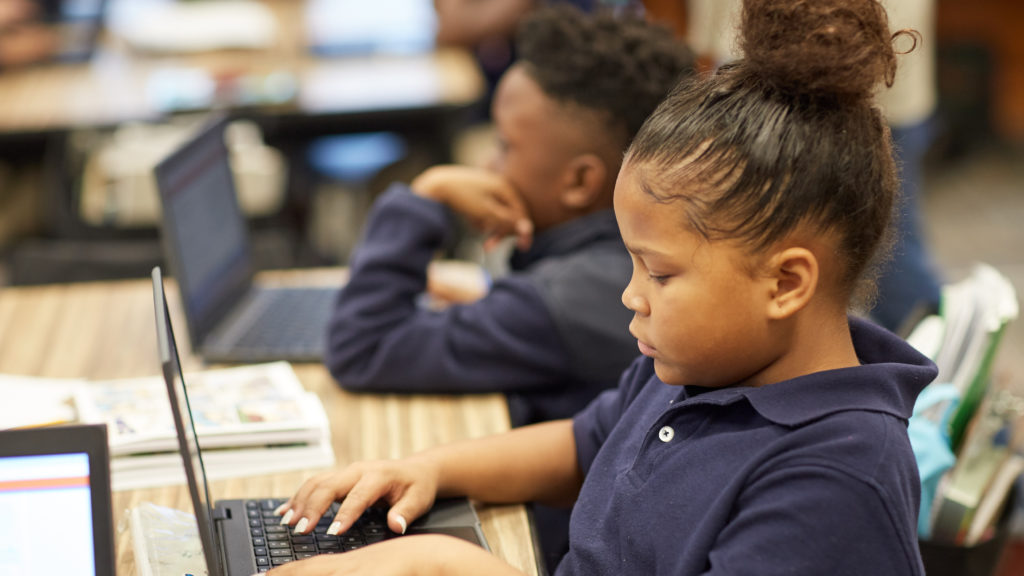Three much-admired school networks in Indianapolis didn’t skip a beat in going virtual.
At Purdue Polytechnic High School, which enrolls 442 students at two campuses in the city, remote learning kicked off this past Monday, after schools closed throughout the city last Friday afternoon. By Tuesday, 95 percent of Purdue’s North Campus students were attending virtually—slightly above the school’s average daily attendance.
Last year, Purdue students, 65 percent of whom are children of color and more than 50 percent are in low-income households, outperformed students statewide on Indiana’s ISTEP high school assessment and trounced their district peers, with nearly twice the number of students passing both the math and English Language Arts components.
When the crisis came, there was little need for reinvention. In a charter school that stresses project and experiential learning, students were accustomed to working on their individual laptops. Instead of gathering in person each morning in their “personal learning communities,” they simply signed into Google Hangouts for a video meeting with their classmates. To sustain their community, students gave one another virtual tours of their home settings. For much of the day, students continued to work in small groups, connected by video, as they tackled their fifth major project of the year. Sophomores are working with staff at Eli Lilly on a specific problem of their choosing that engages the larger question, “How might we expand the healthy human life cycle worldwide?” At the project’s completion, they will be assessed on three key academic and professional competencies.
Students continue to master academic content, aligned with state standards, on Edmentum, where they watch brief instructional videos and complete online assessments to demonstrate mastery. Small-group academic interventions, or “dojos,” are now held on Web Whiteboard, and every student receives one-on-one coaching at least once a week. Scott Bess, head of school, explained that individual and group counseling continues, and that schools are working with itinerant providers to sustain student services. Even the networks’s nurse is online and offering virtual yoga classes to students who may be experiencing anxiety. “We believe strongly that there are ways of providing PT and OT in creative ways,” he told me. “We’ve been documenting the time and services we’re providing.” Bess is undeterred by legal uncertainty over special education compliance and virtual schooling. “We are absolutely not going to say that because we might get sued by someone we’re not going to provide education.” He explained that the risk is minimal because his staff stays very close to parents.
Perhaps surprisingly, connectivity proved barely an issue. A few students needed help in obtaining discounted internet connections; the school gave a handful of others Kajeet mobile hotspots.
Distance learning also launched Monday at Paramount Schools of Excellence, which operates three charter schools educating nearly 1,000 children in kindergarten through the 8th grade—83 percent from low-income households. Paramount’s flagship school, Paramount Community Heights, was the highest-scoring school in the state last year. Tommy Reddicks, Paramount’s CEO, told me the network began intensive preparations for the pandemic in February. “No teacher didn’t understand this might be coming. We took the perspective that we want to be the best in the country at this.”
He credits their smooth launch to the network’s devotion to systems. “We have top-down buy-in for systems-based and standards-based education, full of rigor,” he said. “To protect our investment, we knew we had to be ready to transition with high fidelity.” Because digital testing in the state began a few years ago, the school already had one device for every student. An elaborate call center was established in each school to triage concerns from parents, whether regarding technical support, translation services, academic needs, or nonacademic needs, such as daycare—“anything that could be breaking down in the home,” as Reddicks put it.
Schools are following an 8 am to 3 pm schedule, barely shorter than before. The day begins with two hours of synchronous instruction, with parents and students engaged by chat. Pearson online products continue to be tapped, as before, for both math and reading; teachers can track students’ progress throughout the day. Reddicks stresses that K-2 is harder; for now, the school is relying on distributing physical packets and picking them up later in the week.
Reddicks expressed great admiration for parents’ commitment. “It’s horrifying to see how many parents will be put out of a job” because of the pandemic’s disruption. “The levels of stress must be out of control,” he said. But on Facebook, parents universally praised the network’s characteristic attention to detail.




